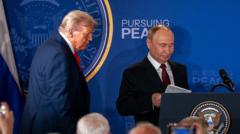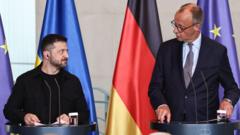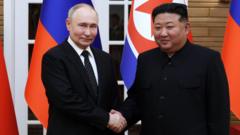NATO Secretary-General Mark Rutte proposes an ambitious plan to increase defense budgets to 5% of GDP, a significant rise from the current 2%, amidst ongoing tensions with Russia and demands from former President Donald Trump.
**NATO's New Defense Spending Agenda: Aiming for 5% by 2033**

**NATO's New Defense Spending Agenda: Aiming for 5% by 2033**
European allies seek to bolster defense spending to meet U.S. pressures ahead of key meetings.
NATO Secretary-General Mark Rutte is determined to make a significant breakthrough at the upcoming NATO summit, aiming to appease former President Donald Trump over defense spending. Following past tensions in 2016, where Trump criticized European nations for inadequate defense budgets, Rutte has proposed that NATO members allocate 5% of their Gross Domestic Product (GDP) on defense, vastly exceeding the current target of 2%. This proposal comes as countries navigate the delicate balance of collective security and international expectations.
At a press conference held in Brussels, Rutte presented a compromise that would require NATO nations to boost core defense spending to 3.5% of GDP. The remaining 1.5% could be accounted for under the broad category of "defense-related expenditure," potentially including costs for infrastructure upgrades and defense industry investments. This approach might give countries flexibility while adhering to a more substantial commitment, which many see as necessary to counter Russia's activities.
Rutte asserted that the U.S. would also adopt the new spending target, although for them, it represents only a minor adjustment from their current expenditure of 3.4%. The proposed timeline for achieving these goals is likely around a decade, with no enforceable penalties for those falling short of the commitments laid out.
During the Brussels meeting, U.S. Defense Secretary Pete Hegseth expressed optimism regarding countries such as France, Germany, Poland, Greece, and Hungary that he claimed had already agreed to the 5% target. Hegseth emphasized the importance of these commitments, particularly highlighting the need for the UK to align with these new goals to ensure collective security within NATO.
In the wake of these proposed changes, Rutte is scheduled to visit the UK next week for talks with Prime Minister Sir Keir Starmer. The UK’s present defense commitment is to reach 2.5% of GDP by 2027, aspiring to elevate it to 3% in subsequent years, which underscores the challenges ahead for European nations in meeting NATO's ambitious spending targets.
As conversations continue surrounding NATO's future direction, the focus remains on how to balance national interests with collective security, especially in an era marked by geopolitical instability.
At a press conference held in Brussels, Rutte presented a compromise that would require NATO nations to boost core defense spending to 3.5% of GDP. The remaining 1.5% could be accounted for under the broad category of "defense-related expenditure," potentially including costs for infrastructure upgrades and defense industry investments. This approach might give countries flexibility while adhering to a more substantial commitment, which many see as necessary to counter Russia's activities.
Rutte asserted that the U.S. would also adopt the new spending target, although for them, it represents only a minor adjustment from their current expenditure of 3.4%. The proposed timeline for achieving these goals is likely around a decade, with no enforceable penalties for those falling short of the commitments laid out.
During the Brussels meeting, U.S. Defense Secretary Pete Hegseth expressed optimism regarding countries such as France, Germany, Poland, Greece, and Hungary that he claimed had already agreed to the 5% target. Hegseth emphasized the importance of these commitments, particularly highlighting the need for the UK to align with these new goals to ensure collective security within NATO.
In the wake of these proposed changes, Rutte is scheduled to visit the UK next week for talks with Prime Minister Sir Keir Starmer. The UK’s present defense commitment is to reach 2.5% of GDP by 2027, aspiring to elevate it to 3% in subsequent years, which underscores the challenges ahead for European nations in meeting NATO's ambitious spending targets.
As conversations continue surrounding NATO's future direction, the focus remains on how to balance national interests with collective security, especially in an era marked by geopolitical instability.






















